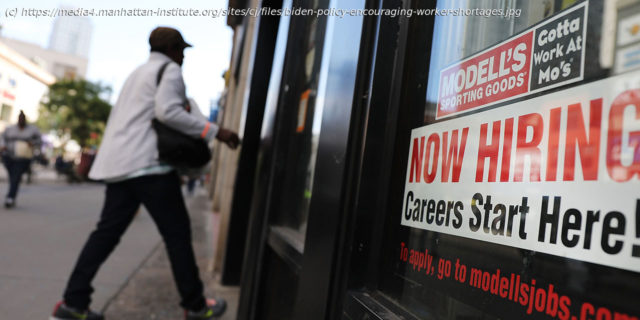As businesses struggle to fill job openings, Biden touts the advantages of worker shortages.
At a Cincinnati town hall meeting in July, a local restaurant owner complained to President Biden about how hard it was to find workers even though millions of Americans remain unemployed. Not exactly striking a sympathetic note, Biden told the restaurateur that he expected enterprises like his “to be in a bind for a while,” because “I think it really is a matter of people deciding now that they have opportunities to do other things.” The president didn’t explain what those “other things” might be, but he clearly didn’t seem worried, even though the recovery from the 2020 recession was already sputtering as millions remained unemployed and businesses frantically searched for new hires. While some industries report shortages because their workers are trading up to better jobs elsewhere, America’s work-participation rate—the percentage of adults holding jobs—has plummeted. In the process, the widespread worker shortages of mid-summer have gotten worse. Back in July, the federal government was still paying enhanced benefits to the unemployed—even though many in Washington, including prominent Democrats, were warning that the federal handouts on top of state unemployment payments were creating a big disincentive to go back to work. That extra federal payment, which had begun under President Trump and was extended by Biden last March, finally ended in early September, but other federal aid continues. The IRS, for instance, now pays families a child tax credit that has expanded to $3,600 per child under six and $3,000 per older child. A recent study estimated that this lucrative benefit, if it becomes permanent as some Democrats have proposed, could prompt up to 1.5 million more mostly low-income parents to leave the workforce over the next few years. Meantime, the Treasury Department has told states that they can use some of the $350 billion stimulus money Washington was sending them to support and expand their own unemployment benefits. Even before the Covid-induced recession struck, public policy in America had been increasingly discouraging work through expanded and more generous disability payments, longer bouts of enhanced, less restrictive unemployment benefits, and more generous social-welfare payments. One consequence: the ranks of the permanently unemployed have grown in America. In the last 20 years alone, the country’s labor-participation rate shrank from nearly 68 percent of adults to just 63 percent right before the Covid lockdowns began. Then in March 2020, the rate slipped below 61 percent—an unprecedented drop. Since then, it’s climbed less than halfway back to pre-Covid level, despite widespread business re-openings and help-wanted signs everywhere. More people are getting used to not working, and the Biden administration’s proposals for expanding federal aid programs will do little to lure them back. That’s apparently fine with Biden and his economic advisors. Far from being horrified at the growing number of permanently out-of-work Americans, the administration sees worker shortages as a way to achieve one of its primary economic goals: raising wages. Biden campaigned on boosting the federal minimum wage to $15.






